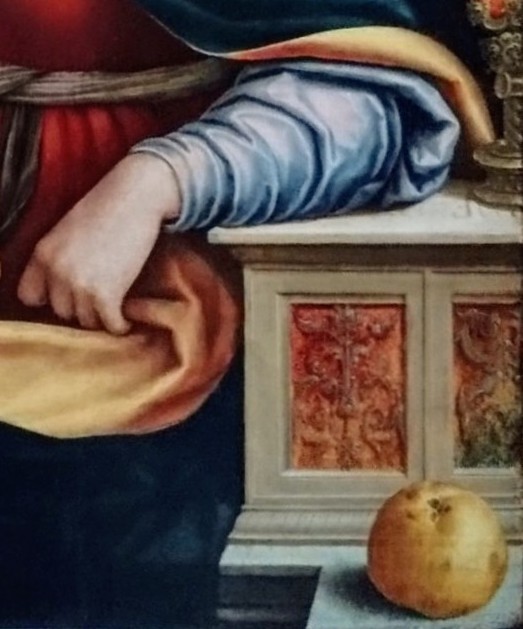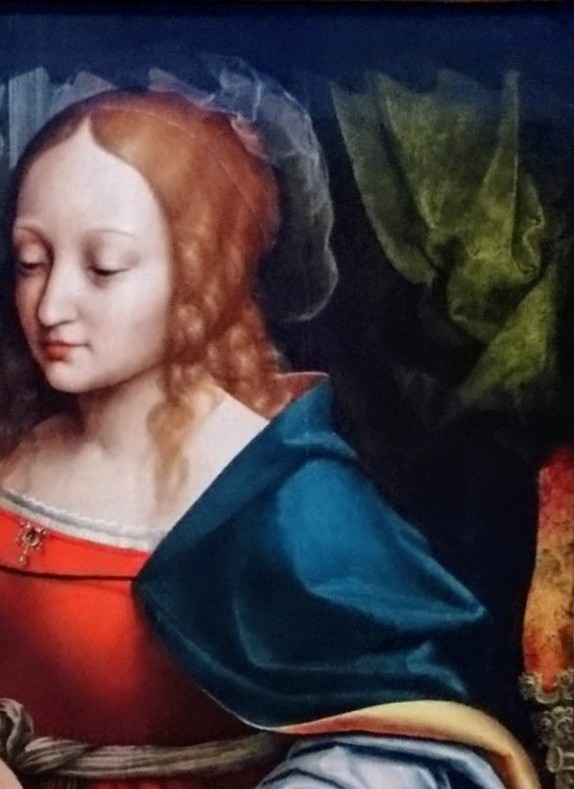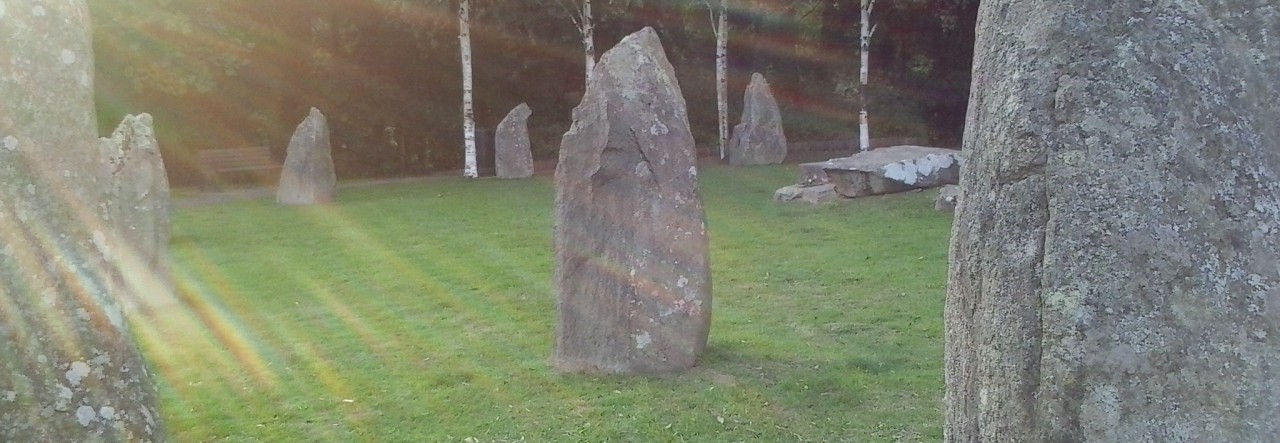
Two, four, six, eight,
Mary at the cottage gate
Eating cherries off a plate,
Two, four, six, eight.
As we hurtle towards the end of this most eventful, least forgettable year, and we approach the day when we are encouraged to trust that peace may come to people of good will, let us pause awhile and contemplate one version of the image that is associated with Christmas, the Madonna and Child.
With this final visit to the canvases of Bristol Museum and Art Gallery for 2020 I present you with my thoughts on a Renaissance painting called The Madonna of the Cherries by Netherlands artist Joos van Cleve, who died around 1540 or 1541, leaving his wife a widow.
Existing in several versions, with the composition sometimes reversed, the Bristol example caught my eye for various reasons, some of which may resonate with you too.

The roughly square canvas is based on a supposed missing original by Leonardo, and the various versions — at least twenty-three — are believed to be either by the Netherlands artist himself or by his studio, as the subject was a popular one. Known alternatively as Joos van der Beke, Joos van der Beken, Joos van Cleef and Master of the Death of the Virgin, Joos van Cleve painted De Madonna met de kersen (as it’s called in Dutch) around 1525 in Antwerp, the city where he worked from 1511 until his death.
What of the subject of the painting? In this interior scene we observe Mary wearing the traditional rich blue cloak over an equally rich red robe, held tight to her body by a sash girdling her waist, the knot situated over where her navel would be. On a plush green cushion sits the naked baby Jesus, twisting his body away from his mother even as he turns his head in her direction, towards her confident, almost smug, gaze. In his podgy hands he holds the bunches of cherries which give the painting its particular title.

At bottom right an apple rests on a ledge: traditionally this references the fruit from the Garden of Eden picked by Eve and is thus symbolic of the Fall. (Much has been made of the fact that Latin malus translates as both ‘bad’ and ‘apple’.) Its presence here tells us that Mary is thought of as the antithesis of Eve by giving birth to Jesus, providing the route to Redemption.
The cherries held by the child (and which explain their inclusion in the title) reinforce that message, being regarded as the Fruits of Paradise. The words of the medieval Cherry Tree Carol echo this belief when Jesus in Mary’s womb is said to command just such a tree to bow down so that the pregnant Mary can pick the ripe cherries with ease.

Through the window at top right behind the Christ Child’s head can be seen a town by a river crossed by a bridge with, closer to the viewer, a fortified manor house with mill and associated buildings. Closer still are farm workers in a ripe wheatfield, the latter possibly alluding to the Eucharist, while the soldiers refer to the legend of the Miracle of the Wheat. In this apocryphal story Herod’s soldiers try to discover exactly when the Holy Family passed by on the Flight into Egypt to escape the Massacre of the Innocents. The peasants truthfully report the trio passed during the period of sowing but don’t admit that the wheat had almost immediately and miraculously risen to full height, ready to be cut. From all this we must assume the painting depicts the Holy Family in a safe haven in Egypt.

An interesting earlier version of this composition (now in a private collection) is ascribed to a certain Giampietrino in Leonardo’s studio, identified as Giovanni Pietro Rizzoli. According to Sotheby’s this version appears to have formed the template for Joos de Cleve’s versions which he adapted to suit North European tastes. We note he has retained the flame-like hair on the Christ Child’s head so typical of Leonardo’s workshop but changed other details: instead of a dramatic North Italian mountainous countryside he has the flattened landscape of the Lowlands; he has introduced Italianate details onto the Madonna’s armrest, rearranged the flashes of colour in the soft furnishings and clothing, and added a level of symbolism not present in the original — the apple, the landscape figures — making the picture significantly more Christian.

In fact, Giampietrino’s painting could merely be a portrait of any mother with her child, the blue cloak and cherries notwithstanding. Joos, on the other hand, has the suggestion of a halo above the woman’s head (though it seems to depict a diaphanous head covering) a detail entirely lacking in the Italian artist’s version.

What else can we draw from this small image, possibly originally meant for private devotion at home rather than in an ecclesiastical setting? In the bottom left corner we see a juxtaposition of the three primary colours (plus green and the flesh tones of a Dutch baby) which, I guess is to increase the vibrancy of the painting. They also emphasise one of the diagonals — from top right to bottom left — with the rich blue of Mary’s cloak on one side and the red garment on the other, and the pale yellow-orange colours (including what seems to be a lit lamp on the far right) linking the two. The preponderance of these bright colours have the effect of keeping the main interest on foreground details, leaving more muted, cooler colours to the background.
I’ve mentioned narrative, composition and colours so far, and now it’s time to note the painting’s emotional impact. Much of that may be attributed to Leonardo’s missing original of course, but going on Giampietrino’s version I believe Joos has added his own touches. The Madonna’s slight smile, suggesting a certain indulgent pleasure, even pride, in her lively offspring may be evident in both, with the Virgin’s calm surrounding his maelstrom of activity; but the additional jewel-like tones and decorative features seem to suggest a warmer, cheerier atmosphere than the sombre shades of the Italian canvas.
I would finally draw attention to Mary’s girdle knot which appears near the midpoint of all the axes, whether diagonals, verticals or horizontals. This very much suggests to me that she is meant to be regarded as the Navel of the World, the axis mundi, the matrix for the world’s redemption.
The veritable cherry on the top.
I found these two sites, accessed this December, helpful for background information as Bristol Museum’s online catalogue didn’t prove helpful, and my 1970 catalogue doesn’t seem to list it (the painting may have been acquired since that date of course).
- https://www.rct.uk/collection/407820/virgin-of-the-cherries
- https://www.sothebys.com/en/auctions/ecatalogue/lot.137.html/2011/important-old-master-paintings-sculpture-n08712
With, below, this final image I’d like to wish you the very best for the season and for the New Year, whether or not the tidings for ‘people of good will’ in your neck of the wood are positive


That’s a remarkable, vibrant painting indeed, thanks for sharing. The artist was unknown to me.
LikeLike
Unknown to me too, Bart, apart from this painting. I agree it’s a vibrant piece—those rich colours may well be one of the aspects that drew to me to it.
LikeLike
The face of Mary is well done too for its time.
LikeLiked by 1 person
I acknowledge your expertise in this field, but it feels so to me as well—it may be just me, but I fancy I detect a mother’s pride here instead of the more beatific smiles of Madonna portraits from the Leonardo studio.
LikeLike
Yes exactly. Evoking emotions in a face like that is really really hard. We tend to underestimate that, and take it for granted because of the masters.
LikeLiked by 1 person
It’s a subtle thing, I agree: we all try to identify and interpret emotions and attitudes in people’s faces, even painted ones. I’m preparing a post about icons for sometime in the new year, about etymology and emotional interactions and so on, and hoping it’s not too pseudo-intellectual…
LikeLiked by 1 person
I’ll gladly read it!
LikeLiked by 1 person
Yay!
LikeLike
Going off the diagonal structures in the painting, is there a redemptive symbolism in cherries, positioned as they are, do you think?
LikeLiked by 1 person
I think you mistake me for a theologian, Michael 😁 I prefer to think Baby Jesus is being a mite selfish: “You can’t have these, mummy, they’re mine, all mine!”
LikeLiked by 1 person
Or, No, mama, these are for my Father! ?
LikeLiked by 2 people
Ah, that’s more likely, the same bumptious attitude he offers Mary when she catches him showing off his superior theology to the teachers in the Temple: “Going about my father’s business” is sooo snooty.
LikeLiked by 2 people
If you’ve got it, flaunt it?
LikeLiked by 1 person
I believe the phrase is, “Never hide your talents under a bushel,” is it not? 🙂
LikeLike
Never take your cherries off your mother? more appropriate?
LikeLike
Can’t find that phrase in my copy of the Old or New Testament, sorry.
LikeLike
The Apocrypha. Has to be.
LikeLiked by 1 person
You’re doubtless referring to the Anagignoskomena, I take it? The Hebrew Masoretic text rather than the Augustinian? I believe Pseudo-Nennius alludes to it…
LikeLiked by 1 person
It… could be that text.
LikeLiked by 1 person
Doubt not, earthling, I am the God of Hellfire and will strike down all unbelievers!
LikeLike
Fascinating post – thank you!
LikeLiked by 1 person
I’m glad this post intrigued, Karen, as much as the original intrigued me!
LikeLiked by 1 person
I wonder what Alexa would send if I ordered cherries.
LikeLike
You’re leaving it very late to ask for a delivery before Christmas Day…
LikeLiked by 1 person
Good point.
LikeLiked by 1 person
🙂
LikeLiked by 1 person
Give the child a break! I have recently seen chubby baby hands squeezing cherries and then shoving them into chubby mouth, purely because they taste delicious. Cherries are at their very best here at the moment.
Hope you have a jolly feast at Christmas Chris with those you hold dear.
LikeLiked by 1 person
OK, I’ll let up on the kid, it’s Christmas after all! 🙂
Nadolig Llawen to you and yours, Gert — it’ll be a quiet one for us but that’s better than none at all, is it not?
LikeLike
Sounds delightful. I feel like an animal reluctantly coming out of hibernation into the light of day.
LikeLiked by 1 person
Lucky you lot with your rather more enlightened government…
LikeLiked by 1 person
CHRIS! Ah, I’ve missed your studies. When you do close-ups like this on paintings I cannot help but sit back and admire the detail, the eye, the hand control, the PATIENCE in the creation of a single image. So much to consider over a single fruit, a single change. How just a few changes can alter the entire theme of a piece. This can work in writing as well, I’d say!
A most blessed and Happy Christmas to you and yours, Friend. See you in the New Year! xxxxxxxxx
LikeLiked by 1 person
Thanks, Jean, for your kind words and wishes for Christmas, and the same to you and yours! I hoped you might appreciate this, I do like immersing myself within paintings, representational examples telling the richest stories, and this seemed a good piece to discuss for the season.
LikeLiked by 1 person